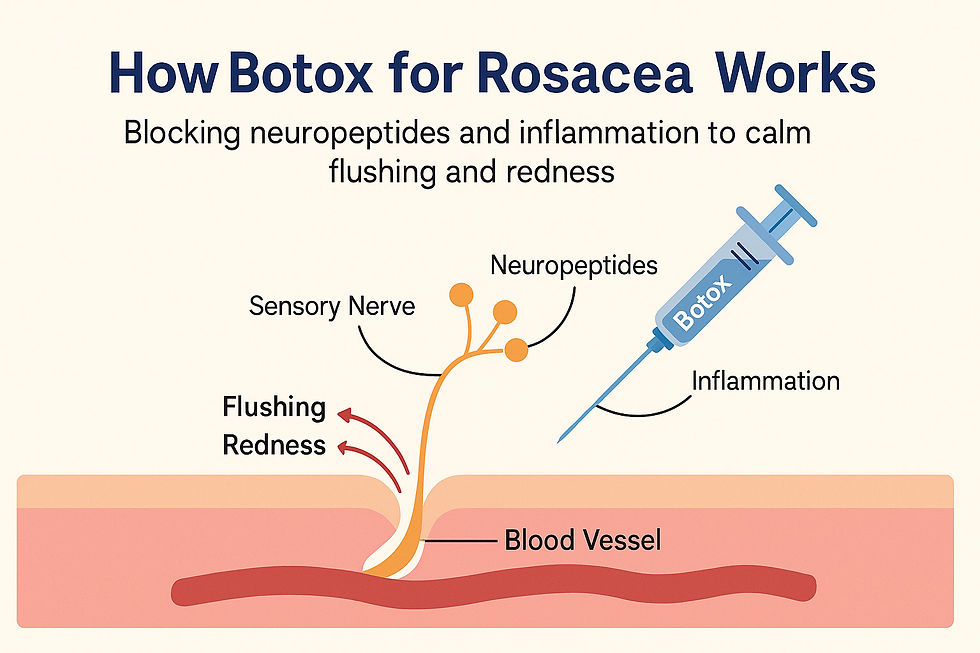Preserving Prosperity By Extending Health Span Of Society One Patient At A Time

Nee Soon Clinic
21 Sept 2025
Emerging evidence now shows that Botox for Rosacea may offer a promising new avenue for redness relief
Rosacea—particularly its hallmark symptoms of persistent erythema and flushing—can be emotionally distressing and difficult to manage.
Emerging evidence now shows that Botox for Rosacea may offer a promising new avenue for redness relief. From neurovascular modulation to anti-inflammatory pathways, here’s a comprehensive, evidence-backed exploration.
What Is Rosacea?
Rosacea is a chronic dermatological condition affecting roughly 5% of people worldwide. It typically presents with facial redness, visible blood vessels (telangiectasia), and, in some cases, bumps or swelling—especially on the nose, cheeks, chin, and forehead.
Type of Rosacea | Characteristics |
Erythematotelangiectatic | Persistent redness, flushing, visible blood vessels |
Papulopustular | Includes acne-like bumps and pimples |
Phymatous | Skin thickening, often on the nose (e.g., rhinophyma) |
Ocular | Dry, irritated, red eyes |
Traditional treatments include topical metronidazole, oral antibiotics, brimonidine creams, and laser therapy.
What Is “Botox for Rosacea”?
Botox for Rosacea refers to the off-label use of intradermal botulinum toxin (typically type A) to reduce facial redness and flushing. Unlike its cosmetic use for wrinkles, this technique targets nerve-mediated blood vessel dilation and inflammatory pathways.
How Does Botox for Rosacea Work?

1. Neurovascular Modulation
Botulinum toxin blocks the release of several neurotransmitters including acetylcholine, calcitonin gene-related peptide (CGRP), substance P, and vasoactive intestinal peptide (VIP)—all involved in causing vasodilation and flushing.
2. Anti-Inflammatory Action
Studies indicate Botox also inhibits mast cell degranulation, reducing local skin inflammation associated with rosacea.
3. Reducing Persistent Erythema
Through these mechanisms, Botox decreases persistent redness and improves skin comfort in rosacea patients.
Clinical Evidence Supporting Botox for Rosacea
Systematic Reviews & Meta-Analyses
2021 Systematic Review (H. Zhang et al.) found botulinum toxin to have a "satisfying efficacy and safety" profile in treating rosacea.
Alsaati et al., 2023 Review: Noted improvements in flushing and erythema lasting 3–6 months, with low adverse event rates. Highlighted limitations like small sample sizes and potential bias.
Key Studies
Y. Jiang et al., 2024 found intradermal BTX to be a useful and safe new option, especially for erythematotelangiectatic rosacea (Wiley Online Library).
Yang et al., 2022: Sixteen patients treated with BTX‑A had improved flushing and erythema at 1 month, with effects lasting up to 6 months (SpringerLink).
Hebebrand Study (Dermatology Times): Higher doses (1 U vs. 0.5 U per point) led to significantly better reduction in erythema and improved quality of life (Dermatology Times).
Pilot Study (Vasconcellos et al., 2021): 75% of patients reported reduced flushing/erythema with intradermal Botox; no serious adverse events noted (ResearchGate).
Technique & Treatment Protocol
Botox is administered via intradermal microinjections across affected areas like the cheeks, nose, and chin.
Doses typically range from 0.5 to 1 unit per injection point, though higher doses may offer better results.
Treatment effects usually begin in 1–2 weeks, lasting 3–6 months before repeat injections are needed.
Safety & Considerations
Adverse effects are generally mild, including localized bruising, redness, or slight muscle weakness.
Muscle paralysis risk exists if too much is used or injected too deeply; doses under 0.02 mL per site mitigated this in studies.
Currently off-label, requiring an experienced injector and thorough patient counseling.
Further large-scale, controlled trials are needed to standardize dosing, protocol, and long-term efficacy.
Summary Table
Aspect | Details |
Mechanism | Blocks acetylcholine, CGRP, VIP, substance P; anti‑inflammatory via mast cell inhibition |
Onset | 1–2 weeks |
Duration | 3–6 months |
Dosing | ~0.5–1 U per point; optimized dosing still under study |
Side Effects | Mild bruising, temporary weakness; no serious events reported |
Evidence Level | Promising pilot studies, systematic reviews, and emerging clinical trials |
Clinical Implication & Further Learning
Treating erythematotelangiectatic rosacea with Botox for Rosacea may significantly improve patients' quality of life by reducing both the visibility and discomfort of facial redness. While still investigational, the accumulating evidence supports further exploration in specialist dermatology clinics.
For clinic patients exploring Botox-based treatments, you might link to this internal resource on aesthetic options: Neesoon Clinic – Botox Singapore.
For a broader medical overview of botulinum toxin, see the authoritative resource on its mechanism and uses: the Wikipedia article on Botulinum toxin.
Final Thoughts
Botox for Rosacea is an exciting off-label treatment with scientific backing in neurovascular modulation and anti-inflammatory action.
Clinical studies demonstrate meaningful symptom relief lasting several months. Still, it's essential to proceed with caution, ideally within clinical trial frameworks or under expert dermatological supervision.
Disclaimer:
The information provided in this article is for informational purposes only and is not intended as a substitute for professional medical advice, diagnosis, or treatment. Always seek the advice of your physician or other qualified health provider with any questions you may have regarding a medical condition. The content is not intended to be a comprehensive source of information and should not be relied upon as such. Reliance on any information provided in this article is solely at your own risk. The authors and the publisher do not endorse or recommend any specific tests, physicians, products, procedures, opinions, or other information that may be mentioned in the article. Any reliance on the information in this article is solely at the reader's own risk.
779 Yishun Ave 2, #01-1547, Singapore 760779
Tel: 6721 9796

